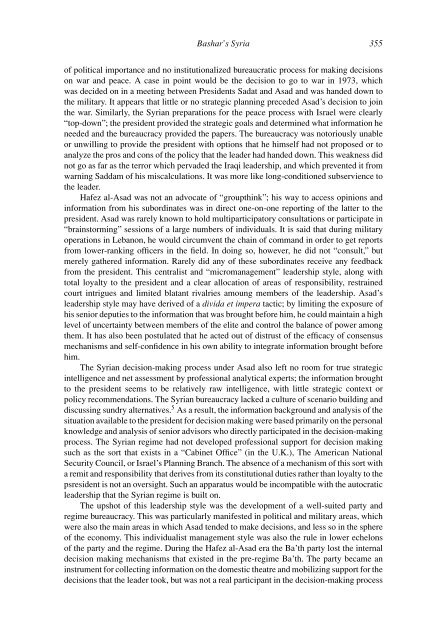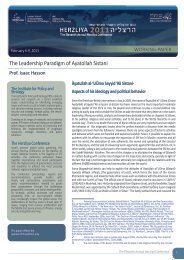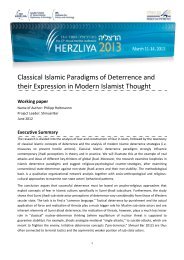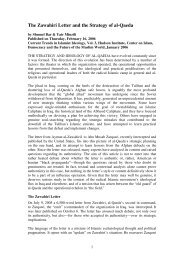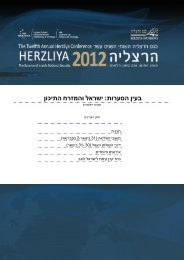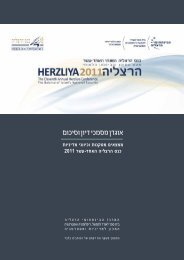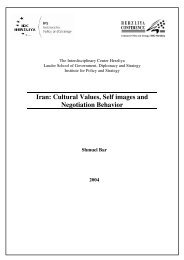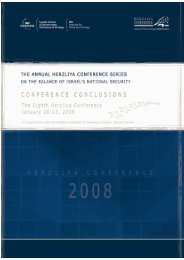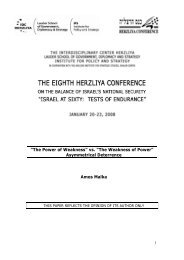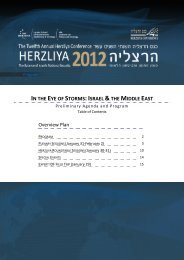Bashar's Syria: The Regime and its Strategic Worldview Shmuel Bar ...
Bashar's Syria: The Regime and its Strategic Worldview Shmuel Bar ...
Bashar's Syria: The Regime and its Strategic Worldview Shmuel Bar ...
You also want an ePaper? Increase the reach of your titles
YUMPU automatically turns print PDFs into web optimized ePapers that Google loves.
Bashar’s <strong>Syria</strong> 355of political importance <strong>and</strong> no institutionalized bureaucratic process for making decisionson war <strong>and</strong> peace. A case in point would be the decision to go to war in 1973, whichwas decided on in a meeting between Presidents Sadat <strong>and</strong> Asad <strong>and</strong> was h<strong>and</strong>ed down tothe military. It appears that little or no strategic planning preceded Asad’s decision to jointhe war. Similarly, the <strong>Syria</strong>n preparations for the peace process with Israel were clearly“top-down”; the president provided the strategic goals <strong>and</strong> determined what information heneeded <strong>and</strong> the bureaucracy provided the papers. <strong>The</strong> bureaucracy was notoriously unableor unwilling to provide the president with options that he himself had not proposed or toanalyze the pros <strong>and</strong> cons of the policy that the leader had h<strong>and</strong>ed down. This weakness didnot go as far as the terror which pervaded the Iraqi leadership, <strong>and</strong> which prevented it fromwarning Saddam of his miscalculations. It was more like long-conditioned subservience tothe leader.Hafez al-Asad was not an advocate of “groupthink”; his way to access opinions <strong>and</strong>information from his subordinates was in direct one-on-one reporting of the latter to thepresident. Asad was rarely known to hold multiparticipatory consultations or participate in“brainstorming” sessions of a large numbers of individuals. It is said that during militaryoperations in Lebanon, he would circumvent the chain of comm<strong>and</strong> in order to get reportsfrom lower-ranking officers in the field. In doing so, however, he did not “consult,” butmerely gathered information. Rarely did any of these subordinates receive any feedbackfrom the president. This centralist <strong>and</strong> “micromanagement” leadership style, along withtotal loyalty to the president <strong>and</strong> a clear allocation of areas of responsibility, restrainedcourt intrigues <strong>and</strong> limited blatant rivalries amoung members of the leadership. Asad’sleadership style may have derived of a divida et impera tactic; by limiting the exposure ofhis senior deputies to the information that was brought before him, he could maintain a highlevel of uncertainty between members of the elite <strong>and</strong> control the balance of power amongthem. It has also been postulated that he acted out of distrust of the efficacy of consensusmechanisms <strong>and</strong> self-confidence in his own ability to integrate information brought beforehim.<strong>The</strong> <strong>Syria</strong>n decision-making process under Asad also left no room for true strategicintelligence <strong>and</strong> net assessment by professional analytical experts; the information broughtto the president seems to be relatively raw intelligence, with little strategic context orpolicy recommendations. <strong>The</strong> <strong>Syria</strong>n bureaucracy lacked a culture of scenario building <strong>and</strong>discussing sundry alternatives. 5 As a result, the information background <strong>and</strong> analysis of thesituation available to the president for decision making were based primarily on the personalknowledge <strong>and</strong> analysis of senior advisors who directly participated in the decision-makingprocess. <strong>The</strong> <strong>Syria</strong>n regime had not developed professional support for decision makingsuch as the sort that exists in a “Cabinet Office” (in the U.K.), <strong>The</strong> American NationalSecurity Council, or Israel’s Planning Branch. <strong>The</strong> absence of a mechanism of this sort witha remit <strong>and</strong> responsibility that derives from <strong>its</strong> constitutional duties rather than loyalty to thepsresident is not an oversight. Such an apparatus would be incompatible with the autocraticleadership that the <strong>Syria</strong>n regime is built on.<strong>The</strong> upshot of this leadership style was the development of a well-suited party <strong>and</strong>regime bureaucracy. This was particularly manifested in political <strong>and</strong> military areas, whichwere also the main areas in which Asad tended to make decisions, <strong>and</strong> less so in the sphereof the economy. This individualist management style was also the rule in lower echelonsof the party <strong>and</strong> the regime. During the Hafez al-Asad era the Ba’th party lost the internaldecision making mechanisms that existed in the pre-regime Ba’th. <strong>The</strong> party became aninstrument for collecting information on the domestic theatre <strong>and</strong> mobilizing support for thedecisions that the leader took, but was not a real participant in the decision-making process


